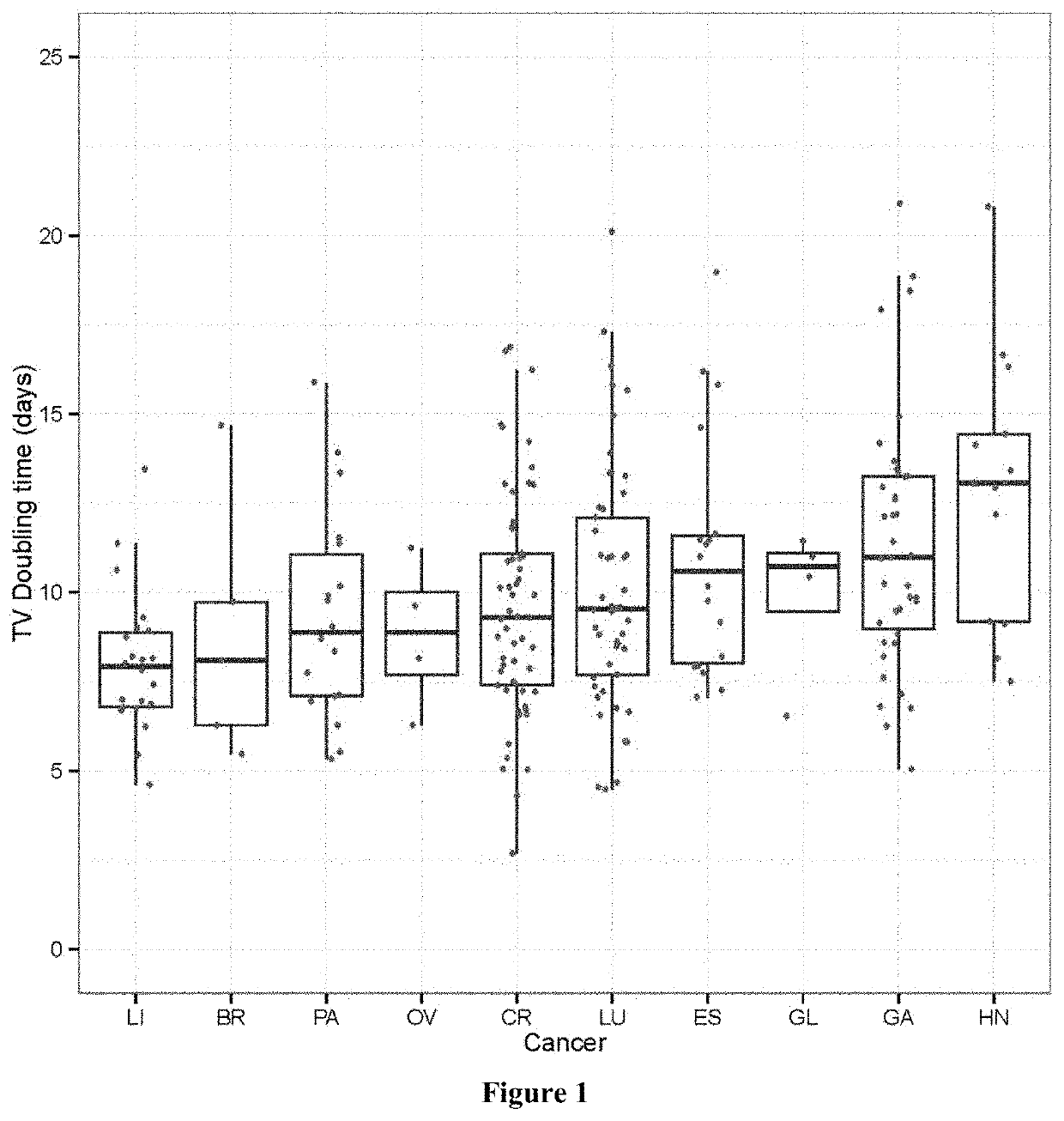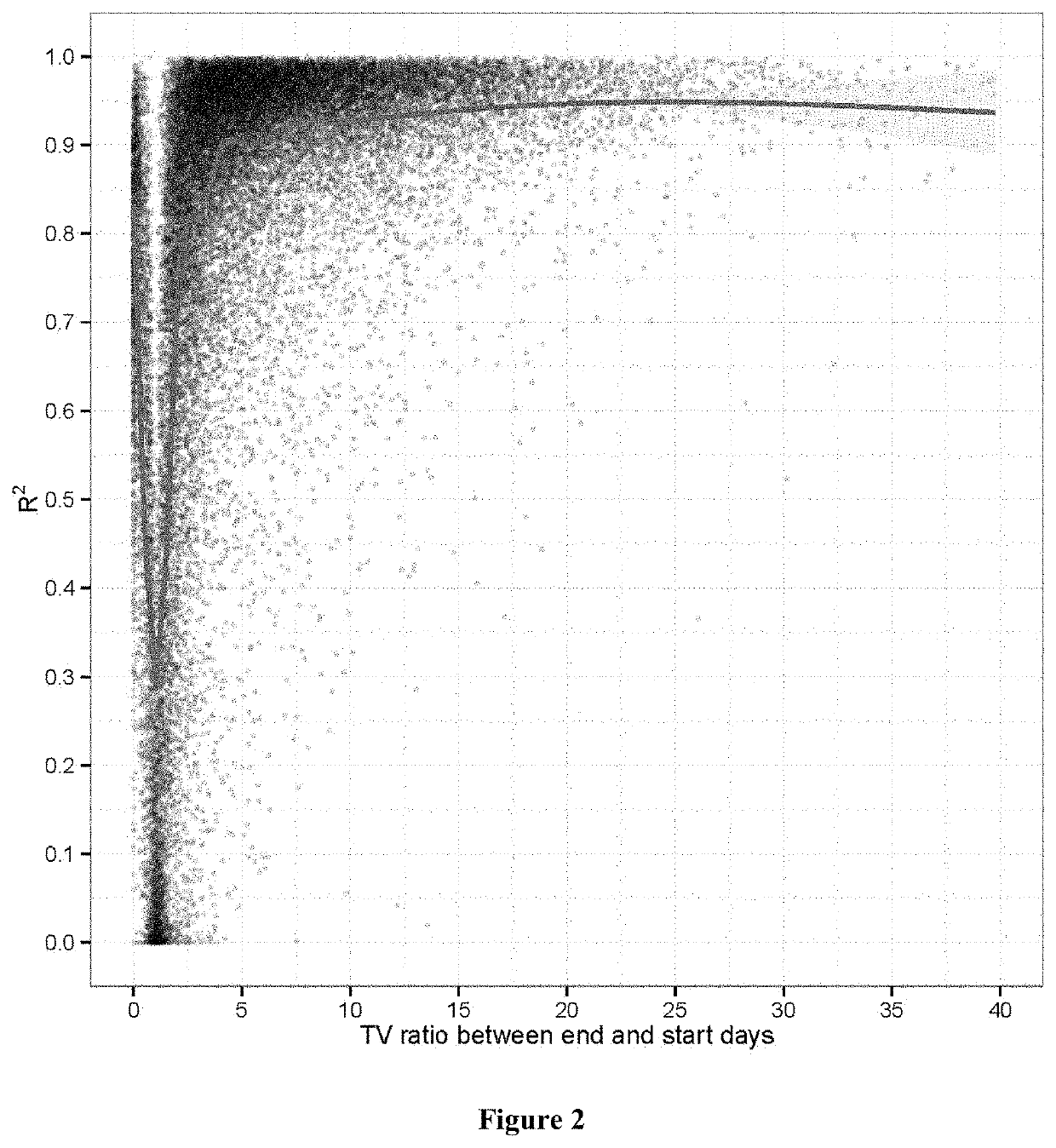Methods of mouse clinical trial
a mouse and clinical trial technology, applied in the field of conducting mouse clinical trials, can solve the problems of limiting the application of tgi, as a primary tumor response endpoint in preclinical cancer pharmacology studies, inadequate scientific theory and practice, and affecting the broad application of tgi
- Summary
- Abstract
- Description
- Claims
- Application Information
AI Technical Summary
Benefits of technology
Problems solved by technology
Method used
Image
Examples
example 1
[0165]This example shows that xenograft tumor growth largely follows exponential kinetics.
[0166]With an aim at developing new method of preclinical cancer pharmacology, we first set out to examine the growth patterns of xenograft tumors. Tumor grows by doubling of tumor cells, therefore, should follow exponential growth in theory. We thus began by testing actual PDX growth to see if it indeed follows exponential kinetics using our large pharmacology datasets of PDX trials. The exponential growth kinetics can be described by
Vx=V0ekx (1)
where V0 is the initial tumor volume normally ranging from 50-300 mm3, Vx is the tumor volume at day x, k is a positive rate parameter. A logarithmic transformation on both sides of the above equation gives the linear equation
ln Vx=ln(V0)+kx (2)
by which the estimate of k, termed {circumflex over (k)}, is obtained. The tumor volume doubling time (T2) is then computed by
ln(2)k^.
Faster growing tumors have larger k and smaller T2.
[0167]We applied Equatio...
example 2
[0170]This example illustrates drug treatment causes complex growth kinetics in PDXs.
[0171]We next examined tumor growth kinetics under various drug treatments. We examined growths of 27771 PDX mice, and found that tumor shrunk for at least one measurement day in 26.0% of them, though some might result from measurement error. At termination point, tumor volume ratio (Ve / V0) of end tumor volume (Ve) versus dosing starting volume (V0) are found to be 0% (2.0% of mice), <100% (10.8% of the mice), ˜100% (˜5% of the mice), <173% (19.8% of mice), <200% (22.8% of mice). Studies also ran longer in drug groups (29.7±14.8 days) than in vehicle groups (24.0±9.1 days).
[0172]We then attempted to assess whether tumor growth still follows exponential kinetics under drug treatment. In general, a more potent drug led to smaller tumors at the end of a study. There was a relationship between the regression R2 and Ve / V0, the ratio between the ending and starting tumor volumes (FIG. 2). The average R2 w...
example 3
[0174]This example illustrates that TGI is a tumor response endpoint biased by tumor growth rate and time of study termination.
[0175]We next investigated Tumor Growth Inhibition (TGI), a commonly used tumor response endpoint, and its variants or equivalent end points, to determine its adequacy for pharmacology evaluation. TGI is defined as
TGI=1-ΔTΔC=1-Vx(T)-V0(T)Vx(C)-V0(C)(3)
where Vx(T) and V0(T) are the tumor volume at day x and day 0 in the drug treatment group; Vx(C) and V0(C) are the corresponding volumes in the vehicle or control group. TGI and ΔT / ΔC equivalently used in practice, and frequently presented in percentage. Usually, there are multiple mice in both drug and vehicle groups, so these 4 tumor volume parameters are the averages or medians. By definition, if there is no response, then TGI=0. If a drug causes tumor growing faster than vehicle, then TGI0; if the tumor volume does not change, then TGI=1, and if the tumor shrinks, i.e. 0≤Vx(T)0(T), then TGI>1.
[0176]To asses...
PUM
| Property | Measurement | Unit |
|---|---|---|
| Volume | aaaaa | aaaaa |
| Volume | aaaaa | aaaaa |
| Level | aaaaa | aaaaa |
Abstract
Description
Claims
Application Information
 Login to View More
Login to View More - R&D
- Intellectual Property
- Life Sciences
- Materials
- Tech Scout
- Unparalleled Data Quality
- Higher Quality Content
- 60% Fewer Hallucinations
Browse by: Latest US Patents, China's latest patents, Technical Efficacy Thesaurus, Application Domain, Technology Topic, Popular Technical Reports.
© 2025 PatSnap. All rights reserved.Legal|Privacy policy|Modern Slavery Act Transparency Statement|Sitemap|About US| Contact US: help@patsnap.com



